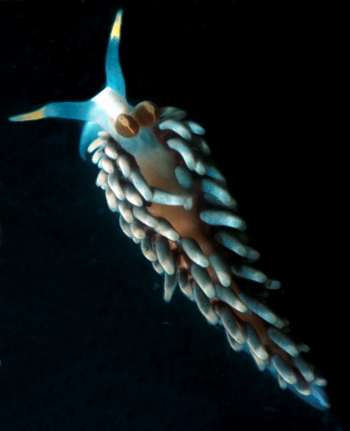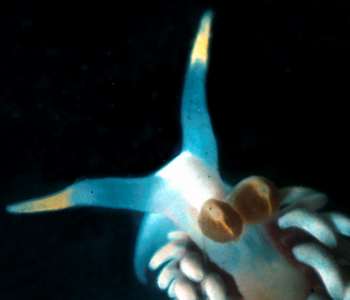

Babakina caprinsulensis
Miller, 1974
Order: NUDIBRANCHIA
Suborder: AEOLIDINA
Family: Glaucidae
DISTRIBUTION
Known only from New Zealand
PHOTO
Holotype. Goat Island Bay, Leigh, North Island, New Zealand. 1 August 1965. 17 mm long alive. Under stone in sub-littoral fringe. Photo: M.C. Miller.
Aeolid with fairly broad body and distinct ridge separating dorsum from the sides. The foot is narrower than the body, and is only visible from above at the head end, where it widens and extends out on each side into tentacular foot corners. The oral tentacles have a wide base and taper to a rounded tip. The rhinophores have a very short stalk and a combined raised basal trunk. The rhinophore clubs are large and covered with papillae, except for a smooth anterior and posterior midline and rounded terminal knob. The cerata are arranged along each side of the body. Miller describes the arrangement as ' six clusters' but any clear pattern is difficult to see.
The body wall is transparent or transplucent with the whitish viscera showing through. There is a broad opaque white band on the head running from the anterior edge back to the rhinophores, and there is a narrower median white stripe from the posterior-most cerata to the posterior tip of the foot. The dorsal surface of thebody and the sides of the head are speckled with purplish pink. The upper third of each oral tentacle is bright yellow, and the rest is translucent clear. The papillate part of the rhinophore club is orange brown, and the tip, at least in the holotype, was bright yellow. The cerata are translucent with the dark brown digestive gland showing though the ceratal wall, which is covered with a dusting of opaque white. Each ceras has a broad subterminal yellowish band.
Miller, considers this species differs only slightly from Babakina festiva (Roller, 1972) originally described from California. Examples of similar animals from Japan and elsewhere are described on the Forum under Babakina cf. festiva. It is possible that all these are geographic variants of a single species. In Miller (1974) the species description is named Babaina caprinsulensis but there is a footnote noting that Babaina Roller, 1972 is preoccupied and has been replaced by Babakina Roller, 1973. This 'internal correction' allows the name to be cited as Babakina caprinsulensis Miller, 1974. The name caprinsulensis is derived from the Latin words for Goat Island, where it was found.
- Miller, M.C. (1974): Aeolid nudibranchs (Gastropoda: Opisthobranchia) of the family Glaucidae from New Zealand waters. Zoological Journal of the Linnean Society, 54: 31-61.
Rudman, W.B., 2005 (March 22) Babakina caprinsulensis Miller, 1974. [In] Sea Slug Forum. Australian Museum, Sydney. Available from http://www.seaslugforum.net/factsheet/babacapr
Related messages
-
Babakina caprinsulensis from New Zealand
From: Ian Skipworth, September 10, 2007 -
Holotype of Babakina caprinsulensis
From: Bill Rudman, March 23, 2005 -
Babakina caprinsulensis from New Zealand
From: Ian Skipworth, March 23, 2005
